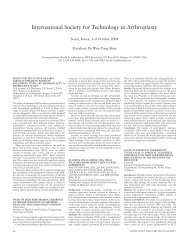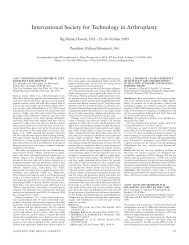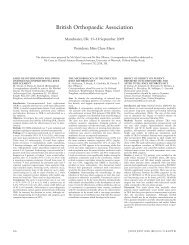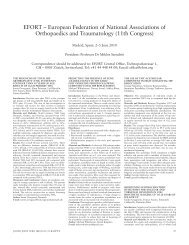Procs III 2011.indb - Journal of Bone & Joint Surgery, British Volume ...
Procs III 2011.indb - Journal of Bone & Joint Surgery, British Volume ...
Procs III 2011.indb - Journal of Bone & Joint Surgery, British Volume ...
Create successful ePaper yourself
Turn your PDF publications into a flip-book with our unique Google optimized e-Paper software.
366 HELLENIC ASSOCIATION OF ORTHOPAEDIC SURGERY AND TRAUMATOLOGY<br />
Pain on VAS and walking distance improved signifi -<br />
cantly at less than 2 years and remained unchanged at 4<br />
years follow-up. Radiographically, spondylolisthesis did<br />
not progress and the motion segments remained stable.<br />
2 patients showed screw-loosening at 1 year follow-up<br />
and underwent revision. Overall, patient satisfaction<br />
remained high as 93% and would undergo the same<br />
procedure again.<br />
In elderly patients with spinal stenosis and degenerative<br />
spondylolisthesis, decompression and dynamic<br />
stabilization lead to excellent clinical and radiologic<br />
results. It maintains enough stability to prevent progression<br />
<strong>of</strong> spondylolisthesis. Because no bone grafting is<br />
necessary, donor site morbidity, which is one <strong>of</strong> the main<br />
drawbacks <strong>of</strong> fusion is eliminated<br />
138 FUNCTIONAL GENOMICS: REVISITING<br />
THE LINK BETWEEN SCOLIOSIS AND<br />
CONGENITAL HEART DISEASE<br />
I. Drosdov, R.J. Macfarlane, C.A. Ouzounis, E.<br />
Tsiridis, M.A. Gatzoulis<br />
Centre for Bioinformatics, School <strong>of</strong> Physical<br />
Sciences & Engineering, King’s College London,<br />
Strand, London, UK; Cardiovascular Division,<br />
<strong>British</strong> Heart Foundation Centre, James Black<br />
Centre, King\’s College London, Denmark Hill,<br />
London, UK; Academic Orthopaedic Unit, Leeds<br />
General Infirmary & Chapel Allerton Teaching<br />
Hospitals, Leeds, UK; School <strong>of</strong> Medicine, Section<br />
<strong>of</strong> Musculoskeletal Disease, Institute <strong>of</strong> Molecular<br />
Medicine, University <strong>of</strong> Leeds, Leeds, UK;<br />
Cardiovascular Division Congenital Heart Centre<br />
& Centre for Pulmonary Hypertension, The Royal<br />
Brompton Hospital and National Heart & Lung<br />
Institute, Imperial College, London, UK<br />
Although previous lnks have been made between congenital<br />
heart disease (CHD) and scoliosis, the molecular<br />
mechanisms involved in this association are poorly<br />
understood. During development, it appears that<br />
embryos exhibiting spine deformations resulting in scoliosis<br />
also suffer from an array <strong>of</strong> cardiac defects. Additionally,<br />
idiopathic scoliosis in patients with CHD is<br />
thought to be a response to a physiological phenomenon<br />
such as an enlarged size or abnormal thrust <strong>of</strong> the heart.<br />
Despite the fact that molecular omics data have been<br />
accumulated that are relevant to these two independent<br />
phenotypes, there appears to be a gap in the literature <strong>of</strong><br />
over two decades on this matter and no clear correlations<br />
<strong>of</strong> the omics data have been provided. To identify genes<br />
involved in CHD and scoliosis, we have performed an<br />
analysis <strong>of</strong> genomic annotations, functional genomics<br />
data and text mining, and derived an inferred network<br />
<strong>of</strong> 123 human genes and 175 known gene interactions.<br />
Of these, 20 genes are unique to CHD, 11 to scoliosis<br />
and 5 genes are common to both abnormalities. These<br />
genes are known to be involved in molecular signaling<br />
cascades that affect the development <strong>of</strong> the musculoskeletal<br />
system in humans and have been associated with<br />
disorders such as the Marfan or CHARGE syndromes.<br />
Our analysis sets the basis upon which investigations <strong>of</strong><br />
this association can be performed at the molecular level,<br />
in order to both further understand the pathology and,<br />
in the future, develop suitable therapies for CHD/idiopathic<br />
scoliosis patients<br />
139 CORRELATION OF THE VOLUME<br />
OF INJECTED CEMENT USING CEMENT<br />
AUGMENTED PEDICLE SCREWS WITH<br />
THEIR PULLOUT STRENGTH. A CADAVER<br />
STUDY<br />
P. Diaremes 1 , MC Kokkinakis 2 , A.A. Kurth 3 , K<br />
Kafchitsas 3<br />
Klinikum Aschaffenburg, Aschaffenburg,<br />
Germany; Stoke Mandeville Hospital, Oxford,<br />
United Kingdom; Department <strong>of</strong> Orthopaedics<br />
and Orthopaedic <strong>Surgery</strong>, Johannes Gutenberg<br />
University Mainz, Germany<br />
The radiological and biomechanical assessment using<br />
cement augmented cannulated pedicle screw (Biomet ® ,<br />
Omega 21 ® ) and the correlation <strong>of</strong> the cement volume<br />
to the pullout strength needed for each screw<br />
Cadaveric vertebrae <strong>of</strong> different lumbar levels were<br />
used. Through cannulated pedicle screw a defi nite volume<br />
<strong>of</strong> cement was applicated. The bone volume occupied<br />
by cement was assessed by means <strong>of</strong> segmentation after<br />
Computer Tomography. Biomechanical Pullout tests and<br />
statistical correlation analysis were then performed<br />
The maximum pullout strength was 1361 N and<br />
the minimum pullout strength was 172 N (SD 331 N).<br />
The maximum cement volume was 5,29 cm3 and the<br />
minimum 1,02 cm3 (SD 1,159).The maximum cement<br />
diameter was 26,6 cm and the minimum cement diameter<br />
was 20,7 cm (SD 1,744). There is statistically signifi<br />
cant correlation between the pullout strength and the<br />
injected cement volume (p








